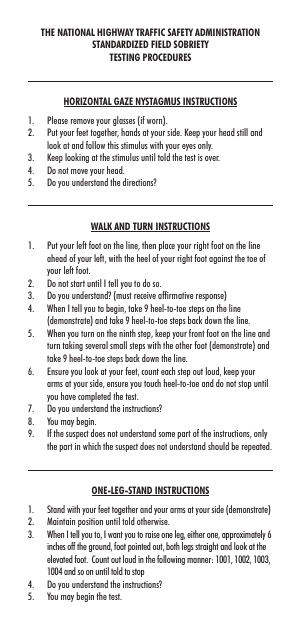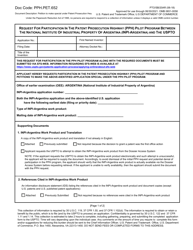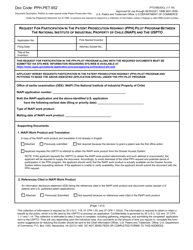The National Highway Traffic Safety Administration Standardized Field Sobriety Testing Procedures - New Jersey
The National Highway Sobriety Testing Procedures is a legal document that was released by the New Jersey Department of Law and Public Safety - Office of The Attorney General - a government authority operating within New Jersey.
FAQ
Q: What is the National Highway Traffic Safety Administration Standardized Field Sobriety Testing Procedures?
A: It is a set of standardized tests used by law enforcement officers to determine if a driver is impaired by alcohol or drugs.
Q: Why are these procedures used?
A: These procedures are used to help identify and apprehend impaired drivers, ensuring the safety of other drivers on the road.
Q: What are the standardized field sobriety tests?
A: The standardized field sobriety tests include the Horizontal Gaze Nystagmus (HGN) test, the Walk-and-Turn test, and the One-Leg Stand test.
Q: What is the Horizontal Gaze Nystagmus (HGN) test?
A: The HGN test involves an officer observing the driver's eyes as they follow a moving object. It can indicate impairment if the eyes jerk involuntarily.
Q: What is the Walk-and-Turn test?
A: The Walk-and-Turn test requires the driver to take nine heel-to-toe steps along a straight line, turn, and take nine heel-to-toe steps back. It assesses balance, coordination, and ability to follow instructions.
Q: What is the One-Leg Stand test?
A: The One-Leg Stand test requires the driver to stand on one leg while counting aloud. It evaluates balance and ability to follow instructions.
Q: Are the standardized field sobriety tests accurate?
A: While they are considered reliable indicators of impairment, they are not infallible. Other factors can affect performance, and additional tests may be necessary for a definitive determination.
Form Details:
- The latest edition currently provided by the New Jersey Department of Law and Public Safety - Office of The Attorney General;
- Ready to use and print;
- Easy to customize;
- Compatible with most PDF-viewing applications;
- Fill out the form in our online filing application.
Download a printable version of the form by clicking the link below or browse more documents and templates provided by the New Jersey Department of Law and Public Safety - Office of The Attorney General.








